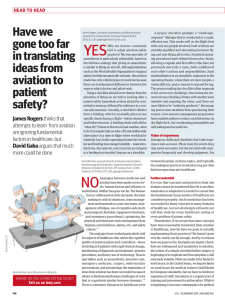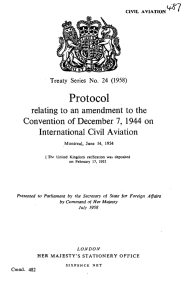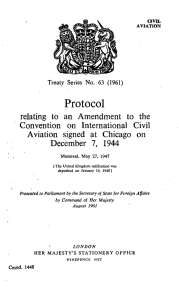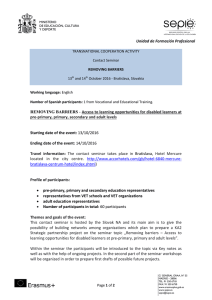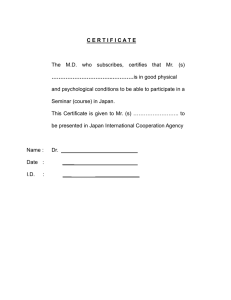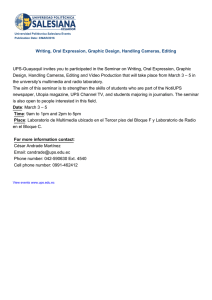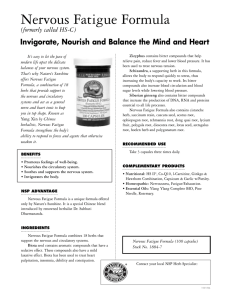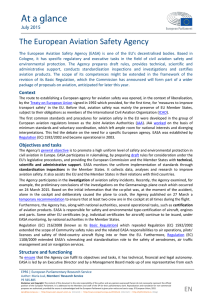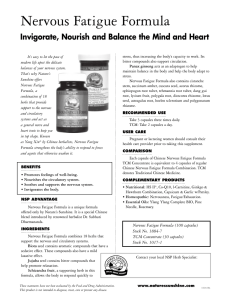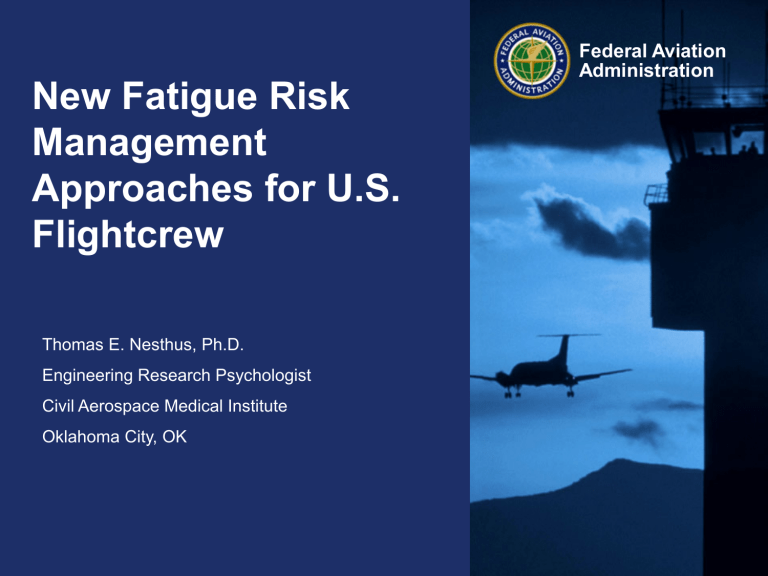
Federal Aviation Administration New Fatigue Risk Management Approaches for U.S. Flightcrew Thomas E. Nesthus, Ph.D. Engineering Research Psychologist Civil Aerospace Medical Institute Oklahoma City, OK Buenos días desde CAMI Fatigue Risk Management in the U.S. Int’l Seminar on Mental Health in Aviation October 26-28, 2015 Federal Aviation Administration 2 Overview of Flightcrew FRM • Recently developed fatigue risk management approaches for U.S. flightcrew – Rulemaking background – 14 CFR Part 117 Flightcrew Member Duty and Rest Requirements – Fatigue Risk Management Plans (FRMP) – Optional Fatigue Risk Management System (FRMS) Fatigue Risk Management in the U.S. Int’l Seminar on Mental Health in Aviation October 26-28, 2015 Federal Aviation Administration 3 Rulemaking Background • FAA considered revising 14 CFR part 121 flight, duty, and rest regulations in June 1992 • Aviation Rulemaking Advisory Committee (ARAC) could not agree on recommendations but FAA issued an NPRM in 1995 • Industry stated FAA lacked safety data to justify the rulemaking, arguing that rules would be too costly • FAA never finalized the 1995 rulemaking Fatigue Risk Management in the U.S. Int’l Seminar on Mental Health in Aviation October 26-28, 2015 Federal Aviation Administration 4 Rulemaking Background • Following Feb 2009 Colgan Air crash FAA chartered an aviation rulemaking committee (ARC) June 24, 2009 • The ARC provided its report to FAA on Sep 9, 2009 • FAA released NPRM on Sep 14, 2010 • FAA received over 8,000 comments • Final Rule published Federal Register Jan 4, 2012 • 14 CFR part 117 implemented Jan 4, 2014 Fatigue Risk Management in the U.S. Int’l Seminar on Mental Health in Aviation October 26-28, 2015 Federal Aviation Administration 5 New Regulation • Underlying philosophy is that no single element of the rule mitigates the risk of fatigue to an acceptable level, thus – Both carrier and pilot are responsible for managing fatigue – Carrier provides “environment”; Crewmembers wisely utilize “environment” for sleep & recovery • Both parties must meet their respective responsibilities in order to adequately manage fatigue Fatigue Risk Management in the U.S. Int’l Seminar on Mental Health in Aviation October 26-28, 2015 Federal Aviation Administration 6 Federal Register / Vol. 77, No. 2 / Wednesday, January 4, 2012 / Rules and Regulations III. Discussion of Public Comments and Final Rule A. Applicability B. Definitions C. Fitness for Duty D. Fatigue Education and Training E. Fatigue Risk Management System F. Flight Duty Period— Unaugmented G. Flight Time Limitations Fatigue Risk Management in the U.S. Int’l Seminar on Mental Health in Aviation October 26-28, 2015 H. Flight Duty Period— Augmented I. Schedule Reliability J. Extensions of Flight Duty Periods K. Split Duty L. Consecutive Nights M. Reserve N. Cumulative Limits O. Rest P. Deadhead Transportation Q. Emergency & Government Sponsored Operations R. Miscellaneous Issues Federal Aviation Administration 7 14 CFR Part 117 Overview Applicability Definitions Limitations Extensions Consecutive Nighttime Operations Mitigations Coffee Break Fatigue Risk Management in the U.S. Int’l Seminar on Mental Health in Aviation October 26-28, 2015 Federal Aviation Administration 8 Applicability All part 121 certificate holders conducting passengercarrying operations All Cargo Operations Continue to operate all-cargo operations under part 121 May opt to apply ALL of its all-cargo operations under the limits of part 117 Fatigue Risk Management in the U.S. Int’l Seminar on Mental Health in Aviation October 26-28, 2015 Federal Aviation Administration 9 Opting Into Part 117 The carrier may NOT segregate those operations between part 117 and 121 Flight time and duty limits must be outlined in the carrier’s FRMP Rest scheme must be consistent with the applicable limits and must be outlined in the carrier’s FRMP Fatigue Risk Management in the U.S. Int’l Seminar on Mental Health in Aviation October 26-28, 2015 Federal Aviation Administration 10 Definitions §117.3 Acclimation Augmented flightcrew member Deadhead transportation Duty Fit for Duty Flight duty period Physiological night’s rest Rest facility (on-board Class 1, 2 or 3) Rest period Suitable accommodation (ground-based) Theater (60 degrees longitude vs. time zone) Fatigue Risk Management in the U.S. Int’l Seminar on Mental Health in Aviation October 26-28, 2015 Federal Aviation Administration 11 Fitness for Duty §117.5 Joint responsibility between the certificate holder and the flightcrew member Must be fit to perform assigned duties Certificate holder may not assign and the flightcrew member may not except an assignment if the flight flightcrew member has reported to be too fatigued to safely perform their assigned duties Once notified, the certificate holder may not allow the flightcrew member to continue an assigned FDP Must attest fitness for duty prior to conducting each segment Fatigue Risk Management in the U.S. Int’l Seminar on Mental Health in Aviation October 26-28, 2015 Federal Aviation Administration 12 FRMS §117.7 Based on scientific principles A data-driven approach to fatigue mitigation An alternative method of compliance Targeted to a specific limitation(s) Must demonstrate an equivalent level of safety against fatigue-related accidents and incidents, as provided in the provisions of part 117 Continuous data reporting requirements Must demonstrate continuous improvement Fatigue Risk Management in the U.S. Int’l Seminar on Mental Health in Aviation October 26-28, 2015 Federal Aviation Administration 13 Fatigue Education and Awareness Training (FEAT) Program (§117.9) Must be FAA-approved Adopted the training standards required in Public Law 111-216, sec. 212(b) Required training for all covered employees Training frequency not to exceed 12 calendar months No grace month provided No AQP FEAT must be updated every 24 calendar months Update must be provided no later than 12 calendar months after the date of the previous FEAT submission Fatigue Risk Management in the U.S. Int’l Seminar on Mental Health in Aviation October 26-28, 2015 Federal Aviation Administration 14 FEAT – Covered Employees All employees responsible for administering the provisions of part 117 Flightcrew members Dispatchers Individuals directly involved with scheduling flightcrew members Individuals directly involved with operational control Any employee providing direct management oversight of those areas Fatigue Risk Management in the U.S. Int’l Seminar on Mental Health in Aviation October 26-28, 2015 Federal Aviation Administration 15 Flight Time Limits May not accept or continue an assigned FDP if the total flight time during that FDP will exceed any of the following: Limits prescribed in Table A of part 117 (Unaugmented flightcrew) 13 hours for a 3-pilot augmented crew 17 hours for a 4-pilot augmented crew Fatigue Risk Management in the U.S. Int’l Seminar on Mental Health in Aviation October 26-28, 2015 Federal Aviation Administration 16 Table A of Part 117 TABLE A TO PART 117 – MAXIMUM FLIGHT TIME LIMITS FOR UNAUGMENTED OPERATIONS Time of report (acclimated) Maximum flight time (hours) 0000-0459 0500-1959 2000-2359 8 9 8 Fatigue Risk Management in the U.S. Int’l Seminar on Mental Health in Aviation October 26-28, 2015 Federal Aviation Administration 17 Flight Time Extensions §117.11 Post takeoff only Unforeseen operational circumstance must have occurred May exceed the flight time limits of § 117.11(a) and the cumulative flight time limits of § 117.23(b) to the extent necessary to safely land at the next destination or alternate airport Fatigue Risk Management in the U.S. Int’l Seminar on Mental Health in Aviation October 26-28, 2015 Federal Aviation Administration 18 Flight Time Extensions The certificate holder must report within 10 days any flight time that exceeded the maximum flight time limits permitted by §117.11(a) or cumulative limits prescribed in §117.23(b). The report must contain a description of the extended flight time limitation and the circumstances surrounding the need for the extension. Fatigue Risk Management in the U.S. Int’l Seminar on Mental Health in Aviation October 26-28, 2015 Federal Aviation Administration 19 FDP Limits – Unaugmented §117.13 May not exceed the limits permitted in Table B of part 117 Limits are based on the scheduled FDP time of start (local time in the theater last acclimated) and the actual number of segments flown Must reduce the applicable limit in Table B of part 117 by 30 minutes if the flightcrew member is not acclimated For the purposes of determining Table B FDP limits, a diversion does not count as a segment. Fatigue Risk Management in the U.S. Int’l Seminar on Mental Health in Aviation October 26-28, 2015 Federal Aviation Administration 20 Table B of Part 117 TABLE B TO PART 117 – FLIGHT DUTY PERIOD: Unaugmented Operations Scheduled time Maximum flight duty period (hours) for of start lineholders based on number of flight segments (acclimated 1 2 3 4 5 6 7+ time) 0000-0359 9 9 9 9 9 9 9 0400-0459 10 10 10 10 9 9 9 0500-0559 12 12 12 12 11.5 11 10.5 0600-0659 13 13 12 12 11.5 11 10.5 0700-1159 14 14 13 13 12.5 12 11.5 1200-1259 13 13 13 13 12.5 12 11.5 1300-1659 12 12 12 12 11.5 11 10.5 1700-2159 12 12 11 11 10 9 9 2200-2259 11 11 10 10 9 9 9 2300-2359 10 10 10 9 9 9 9 Fatigue Risk Management in the U.S. Int’l Seminar on Mental Health in Aviation October 26-28, 2015 Federal Aviation Administration 21 Split Duty §117.15 Is a fatigue mitigation May only be applied to unaugmented operations Split duty rest must occur in a suitable accommodation Rest must be provided between 2200-0500 LOCAL Time in the suitable accommodation must be at least 3 hours beginning when the flightcrew member reaches the suitable accommodation Fatigue Risk Management in the U.S. Int’l Seminar on Mental Health in Aviation October 26-28, 2015 Federal Aviation Administration 22 Split Duty Split duty rest must be scheduled prior to the flightcrew member beginning the FDP in which the split duty rest will be taken The actual rest opportunity taken may not be less than the scheduled rest opportunity The flightcrew member must complete the first segment of the FDP prior to taking the rest period The combined FDP time and the split duty rest may not exceed 14 hours Fatigue Risk Management in the U.S. Int’l Seminar on Mental Health in Aviation October 26-28, 2015 Federal Aviation Administration 23 FDP Limits – Augmented §117.17 May not exceed the maximum applicable limits prescribed in Table C of part 117 FDP limit is based on local time in the theater last acclimated Must reduce the maximum applicable limit in Table C by 30 minutes if not acclimated Fatigue Risk Management in the U.S. Int’l Seminar on Mental Health in Aviation October 26-28, 2015 Federal Aviation Administration 24 FDP Limits - Augmented Pilot making the last landing of the FDP must have available a 2 consecutive hour in-flight rest opportunity in the second half of the FDP Pilot monitoring the last landing of the FDP must have 90 consecutive minutes available for in-flight rest during that FDP FDP is limited to a maximum of 3 segments Fatigue Risk Management in the U.S. Int’l Seminar on Mental Health in Aviation October 26-28, 2015 Federal Aviation Administration 25 Table C of Part 117 TABLE C TO PART 117 – FLIGHT DUTY PERIOD: Augmented Operations Scheduled Maximum flight duty period (hours) based on rest time of facility and number of pilots start Class 1 rest Class 2 rest Class 3 rest (acclimate facility facility facility d time) 3 pilots 4 pilots 3 pilots 4 pilots 3 pilots 4 pilots 0000-0559 0600-0659 0700-1259 1300-1659 1700-2359 15 16 17 16 15 17 18.5 19 18.5 17 14 15 16.5 15 14 Fatigue Risk Management in the U.S. Int’l Seminar on Mental Health in Aviation October 26-28, 2015 15.5 16.5 18 16.5 15.5 13 14 15 14 13 13.5 14.5 15.5 14.5 13.5 Federal Aviation Administration 26 FDP Extensions §117.19 Pre-takeoff or a post takeoff condition Applies to unaugmented and augmented operations If an unforeseen operational circumstance occurs Pre-takeoff circumstances PIC and certificate holder may extend an FDP up to 2 hours above the maximum applicable FDP limit PIC concurrence 30 minutes or less, and 31 minutes or greater Cannot extend the FDP if it exceeds the FDP cumulative limits Fatigue Risk Management in the U.S. Int’l Seminar on Mental Health in Aviation October 26-28, 2015 Federal Aviation Administration 27 FDP Extension 30-hour rest requirement prior to accepting another extension (§117.25(b)) Reporting requirements FDP extension of greater than 30 minutes Report within 10 days of the extension A description of the extension and circumstances If within the control of the certificate holder, develop corrective actions to minimize such occurrences Implement corrective actions within 30 days of the extension Fatigue Risk Management in the U.S. Int’l Seminar on Mental Health in Aviation October 26-28, 2015 Federal Aviation Administration 28 FDP Extensions Post-Takeoff Conditions PIC and certificate holder may extend the FDP limit to the extent necessary to safely land the airplane at the next destination or alternate airport 30-hour rest requirement prior to accepting another extension (§117.25(b)) May exceed the cumulative FDP limits Report within 10 days any FDP that exceeded the cumulative FDP limits, or exceeded the maximum FDP limits permitted by Tables B or C by more than 30 minutes. The report must contain a description of the circumstances surrounding the affected FDP Fatigue Risk Management in the U.S. Int’l Seminar on Mental Health in Aviation October 26-28, 2015 Federal Aviation Administration 29 Consecutive Nighttime Operations §117.27 Two or more consecutive FDPs that infringe on the flightcrew members WOCL Limit with no mitigation: 3 consecutive nighttime FDPs Limit with mitigation: 5 consecutive nighttime FDPs. Fatigue Risk Management in the U.S. Int’l Seminar on Mental Health in Aviation October 26-28, 2015 Federal Aviation Administration 30 Mitigations Rest opportunity of at least 2 hours for each of the 4 or 5 nights Rest opportunity must occur between 2200-0500 LOCAL The rest opportunity provided must be scheduled prior to beginning the FDP The length of the rest opportunity actually provided must equal or exceed the scheduled rest opportunity The rest opportunity is not provided until the first segment of the FDP is completed Any split duty rest that is provided in accordance with §117.15 counts as part of a FDP Fatigue Risk Management in the U.S. Int’l Seminar on Mental Health in Aviation October 26-28, 2015 Federal Aviation Administration 31 QUESTIONS/COMMENTS? Coffee Break? Fatigue Risk Management in the U.S. Int’l Seminar on Mental Health in Aviation October 26-28, 2015 Federal Aviation Administration 32 14 CFR Part 117 Overview (cont.) Cumulative Limitations Rest Part 117 for flight attendants in §121.467 Application of FRMP and FRMS Appendix A-D Website location Associated Advisory Circulars Operations specifications Fatigue Risk Management in the U.S. Int’l Seminar on Mental Health in Aviation October 26-28, 2015 Federal Aviation Administration 33 Cumulative Limitations §117.23 Includes all flying on behalf of any certificate holder or part 91K program manager. Flight time: 100 hours in any 672 consecutive hours or 1,000 hours in any 365 consecutive calendar day period. FDP hours: 60 FDP hours in any 168 consecutive hours, or 190 FDP hours in any 672 consecutive hours Fatigue Risk Management in the U.S. Int’l Seminar on Mental Health in Aviation October 26-28, 2015 Federal Aviation Administration 34 The Rest Test How do I know if my assigned rest period was a rest period? Prospectively scheduled The rest period is continuous Free from all restraint of the carrier, and free from a present responsibility for work, should the occasion arise Fatigue Risk Management in the U.S. Int’l Seminar on Mental Health in Aviation October 26-28, 2015 Federal Aviation Administration 35 Rest Period §117.25 No duty or reserve assignment while on rest Before beginning any reserve or flight duty period a flightcrew member must be given at least 30 consecutive hours free from all duty within the past 168 consecutive hour period (Meets §117.25(e) rest) 36 consecutive hours (re-acclimation) Meets the 30-hour cumulative rest requirements and the minimum rest requirements (§117.25(b)) Fatigue Risk Management in the U.S. Int’l Seminar on Mental Health in Aviation October 26-28, 2015 Federal Aviation Administration 36 Rest Period A minimum of 56 consecutive hours rest upon return to home base if the flightcrew member travels more than 60° longitude during a FDP or a series of FDPs, and is away from home base for more than 168 consecutive hours during this travel. The 56 hours of rest must encompass three physiological nights' rest based on local time (Minimum rest) 10 consecutive hours of rest opportunity with an 8 consecutive hour sleep opportunity before beginning any reserve or an FDP Fatigue Risk Management in the U.S. Int’l Seminar on Mental Health in Aviation October 26-28, 2015 Federal Aviation Administration 37 Rest Period If a flightcrew member determines that a rest period will not provide eight uninterrupted hours of sleep opportunity, the flightcrew member must notify the certificate holder. The flightcrew member cannot report for the assigned FDP until they receive a rest period specified in § 17.25(e) (measured from the release of duty) If a flightcrew member engaged in deadhead transportation exceeds the applicable FDP limits in Table B, the flightcrew member must be given a rest period equal to the length of the deadhead transportation but not less than the required rest in § 117.25(e) before beginning a FDP. Fatigue Risk Management in the U.S. Int’l Seminar on Mental Health in Aviation October 26-28, 2015 Federal Aviation Administration 38 Part §121.467 Part 117 amended §121.467 to reflect the option to apply the part 117 limits to flight attendants If a certificate holder elects to apply the limits of part 117 to its flight attendants, the certificate holder must apply ALL of the limits of part 117 to its flight attendants, except the provisions for rest facilities If the certificate holder applies the limits of part 117 to its flight attendants, it should be outlined in its FRMP Fatigue Risk Management in the U.S. Int’l Seminar on Mental Health in Aviation October 26-28, 2015 Federal Aviation Administration 39 Fatigue Risk Management Plans (FRMP) Statutory requirement Public Law (PL) 111-216, § 212(b) Required by each part 121 air carrier The FRMP describes how the air carrier will manage and mitigate day-to-day pilot fatigue from within the applicable regulatory structure Requires training every 12 calendar months Requires the carrier to update its FRMP at least once every 24-calendar months Is an FAA-accepted document Fatigue Risk Management in the U.S. Int’l Seminar on Mental Health in Aviation October 26-28, 2015 Federal Aviation Administration 40 FRMP Objectives • Primarily to mitigate and manage day-to-day flightcrew member fatigue from within the regulatory structure • How? – Develop and implement fatigue management policies & procedures within the air carrier’s operation – Provide fatigue awareness & education to improve alertness and reduce potential for errors – Continuously assess FRMP performance & adjust with appropriate revisions Fatigue Risk Management in the U.S. Int’l Seminar on Mental Health in Aviation October 26-28, 2015 Federal Aviation Administration 41 FRMP Components Senior-level commitment FRMP polices and procedures Flight and duty limits Rest scheme consistent with limitations Fatigue education and awareness training Fatigue reporting policy Fatigue incident reporting Fatigue monitoring procedures FRMP evaluation process Fatigue Risk Management in the U.S. Int’l Seminar on Mental Health in Aviation October 26-28, 2015 Federal Aviation Administration 42 Generic Guidance for Fatigue Risk Management Systems • Must be data-driven and scientifically-based • Must enable continuous monitoring and management of safety risks associated with fatigue-related hazards • Must provide a means of measuring, mitigating, and reassessing fatigue risk • Must include schedule assessment, data collection, and systematic analysis • Provides scientifically guided fatigue mitigations – both proactive and reactive Fatigue Risk Management in the U.S. Int’l Seminar on Mental Health in Aviation October 26-28, 2015 Federal Aviation Administration 43 Fatigue Risk Management System (FRMS) § 117.7 describes an optional approach or an alternate means of compliance (AMOC) to safely conduct specific flight operations that are currently limited under the rule – Provides carrier with flexibilities not found in the prescriptive regulations – Implementation process will identify and reduce the risk of fatigue relevant to specific operational circumstances Fatigue Risk Management in the U.S. Int’l Seminar on Mental Health in Aviation October 26-28, 2015 Federal Aviation Administration 44 Fatigue Risk Management System (FRMS) Proposed FRMS AMOC must demonstrate an equivalent level of safety (ELOS) Demonstrated by data analysis and must be validated by FAA Must Include: An FRMS management policy, training, fatigue reporting, flight crew fatigue monitoring, incident reporting, and performance evaluation Approved by the Administrator Fatigue Risk Management in the U.S. Int’l Seminar on Mental Health in Aviation October 26-28, 2015 Federal Aviation Administration 45 FRMS § 117.7 states: (a) No certificate holder may exceed any provision of this part unless approved by the FAA under a Fatigue Risk Management System that provides at least an equivalent level of safety against fatigue-related accidents or incidents as the other provisions of this part (b) The Fatigue Risk Management System must include: (1) A fatigue risk management policy (2) An education and awareness training program (3) A fatigue reporting system (4) A system for monitoring flightcrew fatigue (5) An incident reporting process (6) A performance evaluation Fatigue Risk Management in the U.S. Int’l Seminar on Mental Health in Aviation October 26-28, 2015 Federal Aviation Administration 46 FRMS Objectives An optional approach to fatigue mitigation FRMS is a data-driven system based upon scientific principles An alternative method of compliance to the prescriptive rule Targeted to specific limitation(s) FRMS must demonstrate at least an equivalent level of safety against fatigue-related accidents or incidents Requires data collection and monitoring for continuous improvement AC 120-103A Fatigue Risk Management Systems for Aviation Safety Fatigue Risk Management in the U.S. Int’l Seminar on Mental Health in Aviation October 26-28, 2015 Federal Aviation Administration 47 Guidance for FRMS Authorization Process FAA AC 120-103A: FRMS for Aviation Safety (1) Describes the basic concepts of Fatigue Risk Management Systems (2) Provides detailed guidance on critical FRMS components (3) Defines an operations-specific process for a certificate holder’s particular flight operation need a. What limitations of the regulation do they need relief from, e.g., extension of flight duty periods for ULR city-pair (4) Provides details of the FRMS approval process, including the required documentation, safety assurance processes, data collection and analysis, evaluation and validation, OpSpec authorization, and continuous monitoring and reporting Fatigue Risk Management in the U.S. Int’l Seminar on Mental Health in Aviation October 26-28, 2015 Federal Aviation Administration 48 Overview of FRMS Authorization Process 1. Pre-application, Planning, & Assessment Assessment, Planning, and Preparation •Gates 1-4 Detailed FRM Process and 2. Formal Application Procedure Development •Gates 5 & 6 a. Data Collection Prep 3. Documentation & Data Collection Plan •Gate 7 4. Demonstration & Validation b. Petition for exemption c. Data Collection Data Analysis & Validation •Gate 8 5. Authorization, Implementation & Monitoring OpSpec Authorization •Gate 9 Fatigue Risk Management in the U.S. Int’l Seminar on Mental Health in Aviation October 26-28, 2015 Federal Aviation Administration 49 1. Preapplication, Planning, & Assessment Objective: prepare to fully develop proposed FRMS and data collection encompasses Gates 1-4 (1) Needs analysis defines specific flight ops requiring AMOC as well as mitigations, procedures, policies, documentation, resources, & communications (2) Implementation plan including fatigue & incident reporting, monitoring, & training (3) Development of plans for data collection & analysis, and data collection flight operations (4) Development of flightcrew member operational procedures, inflight rest, pre- & post-FDP rest, and a reactive hazard identification and risk assessment Fatigue Risk Management in the U.S. Int’l Seminar on Mental Health in Aviation October 26-28, 2015 Federal Aviation Administration 50 2. Formal Application Primary focus for the FAA will be to determine that the data collection operation can be safely conducted Secondly, the FAA will evaluate the effectiveness of the data collection plan and the data analysis plan Gates 5 & 6 (5) Formal documentation of all elements developed during phase 1 (6) Review, evaluate, and validate: – safety performance indicators – predicted effectiveness of AMOC – periodic evaluation – feedback – process documentation of training, communications, and monitoring Fatigue Risk Management in the U.S. Int’l Seminar on Mental Health in Aviation October 26-28, 2015 Federal Aviation Administration 51 Overview of FRMS Authorization Process 1. Preapplication, Planning, & Assessment Assessment, Planning, and Preparation •Gates 1-4 Detailed FRM Process and 2. Formal Application Procedure Development •Gates 5 & 6 a. Data Collection Prep 3. Documentation & Data Collection Plan •Gate 7 4. Demonstration & Validation b. Petition for exemption c. Data Collection Data Analysis & Validation •Gate 8 5. Authorization, Implementation & Monitoring OpSpec Authorization •Gate 9 Fatigue Risk Management in the U.S. Int’l Seminar on Mental Health in Aviation October 26-28, 2015 Federal Aviation Administration 52 3. Documentation & Data Collection Plan The FAA will evaluate FRMS plan and all documentation supporting flight ops during data collection. Gate 7 (7) Concerns all aspects of flight operations data collection, including: modeling fatigue predictions/mitigations, demonstration of an effective AMOC, another review of safety performance indicators & data analysis methodology. Lastly, determination of applicable exemptions with specific limitations and conditions for data collection flights. Fatigue Risk Management in the U.S. Int’l Seminar on Mental Health in Aviation October 26-28, 2015 Federal Aviation Administration 53 Overview of FRMS Authorization Process 1. Preapplication, Planning, & Assessment Assessment, Planning, and Preparation •Gates 1-4 Detailed FRM Process and 2. Formal Application Procedure Development •Gates 5 & 6 a. Data Collection Prep 3. Documentation & Data Collection Plan •Gate 7 4. Demonstration & Validation b. Petition for exemption c. Data Collection Data Analysis & Validation •Gate 8 5. Authorization, Implementation & Monitoring OpSpec Authorization •Gate 9 Fatigue Risk Management in the U.S. Int’l Seminar on Mental Health in Aviation October 26-28, 2015 Federal Aviation Administration 54 4. Demonstration & Validation Certificate holder will collect & analyze all data associated with the FRMS proposal and submit an analysis package to FAA for review/validation Gate 8 (8) Certificate holder provides “…a complete review and analysis of results…with specific emphasis on how the data confirm that the alternative operation outside the prescriptive rules provides an effective AMOC with safety standards” to the FAA Fatigue Risk Management in the U.S. Int’l Seminar on Mental Health in Aviation October 26-28, 2015 Federal Aviation Administration 55 AMOC and Statistical Procedures • Traditional ANOVA or t-tests look primarily at variability and group differences – However, we cannot conclude equivalence from a difference test…Why? • Because non-significance can be the result of a number of things including small samples with inadequate power to show differences • Altman & Bland (1996) stated: “Absence of evidence is not evidence of absence” – This simply means that the data are inadequate to determine if there is a difference – A difference might still be found with a larger sample size Altman, DG and Bland, JM. Absence of evidence is not evidence of absence. BMJ 1995, Aug 19, 311(7003):485 Fatigue Risk Management in the U.S. Int’l Seminar on Mental Health in Aviation October 26-28, 2015 Federal Aviation Administration 56 Statistical Procedures (cont.) • But, there are methods to test group equivalency, and should be implemented whenever this is the true goal of the research question – Since it is not possible to prove that two treatments are identical, such as with generic vs original drug formulations*, the aim is to show that they do not differ by more than a specified and immaterial amount • By using this analysis approach, you must determine what a meaningful/practical difference is, even before you start *FDA (1992), “Bioavailability and Bioequivalence Requirements,” in U. S. Code of Federal Regulations (vol. 21, chap. 320),Washington, DC: U. S. Government Printing Office Fatigue Risk Management in the U.S. Int’l Seminar on Mental Health in Aviation October 26-28, 2015 Federal Aviation Administration 57 Regular t-test vs. Two OneSided Tests (TOST) Approach Wellek, S. (2010). Testing Statistical Hypotheses of Equivalence and Noninferiority. Fatigue Risk Management in the U.S. Int’l Seminar on Mental Health in Aviation October 26-28, 2015 Federal Aviation Administration 58 Confidence Intervals and Practical Differences Approach Fatigue Risk Management in the U.S. Int’l Seminar on Mental Health in Aviation October 26-28, 2015 Federal Aviation Administration 59 Overview of FRMS Authorization Process 1. Preapplication, Planning, & Assessment Assessment, Planning, and Preparation •Gates 1-4 Detailed FRM Process and 2. Formal Application Procedure Development •Gates 5 & 6 a. Data Collection Prep 3. Documentation & Data Collection Plan •Gate 7 4. Demonstration & Validation b. Petition for exemption c. Data Collection Data Analysis & Validation •Gate 8 5. Authorization, Implementation & Monitoring OpSpec Authorization •Gate 9 Fatigue Risk Management in the U.S. Int’l Seminar on Mental Health in Aviation October 26-28, 2015 Federal Aviation Administration 60 5. Authorization, Implementation & Monitoring Upon satisfactory completion of this process, the FAA may grant authorization to operate in accordance with the FRMS flight operation by issuance of OpsSpec A318 Gate 9 (9) Issues OpsSpec A318 with time restrictions and an audit schedule along with an ongoing Safety Assurance process to monitor the continued success of the FRMS operation. Monitoring data will be provided to the FAA at specified time intervals for evaluation. Fatigue Risk Management in the U.S. Int’l Seminar on Mental Health in Aviation October 26-28, 2015 Federal Aviation Administration 61 How Science Supplements the Flight and Duty Time Rules Fatigue Risk Management in the U.S. Int’l Seminar on Mental Health in Aviation October 26-28, 2015 Federal Aviation Administration 62 How Science Supplements the Flight and Duty Time Rules Features of Rule Science Limitation Data-driven Mitigation Part 117 is a set of fixed duty limits and rest requirements People and situations vary and may combine on any given day to reduce performance below the level normally expected under the fixed limits. The crewmember must certify fitness for duty prior to each flight segment. The PIC must accept FDP extensions. These two “data” driven requirements mitigate variability that could cause fatigue or excessive duty demands in actual operations. Fatigue Risk Management in the U.S. Int’l Seminar on Mental Health in Aviation October 26-28, 2015 Federal Aviation Administration 63 How Science Supplements the Flight and Duty Time Rules Features of Rule Science Limitation Data-driven Mitigation Part 117 may classify a specific situation as “safe” when, in practice, it is fatiguing Not all fatiguing situations can be anticipated by a set of static limits that don’t model the dynamic interaction of factors or the cumulative effects of fatigue. The FRMP process allows for fatigue reports to identify hazardous situations and requires the operator to conduct a root cause analysis to mitigate such unanticipated or complex interactions that can cause fatigue in practice, within the regulatory limits. Fatigue Risk Management in the U.S. Int’l Seminar on Mental Health in Aviation October 26-28, 2015 Federal Aviation Administration 64 How Science Supplements the Flight and Duty Time Rules Features of Rule Science Limitation Part 117 may classify a specific situation as “unsafe” when, in fact, a set of mitigations can be arranged that would make the situation safe. Some situations are misclassified as unsafe because the rule does not consider all possibilities of additional rest or constrained duty that would render the situation safe. Fatigue Risk Management in the U.S. Int’l Seminar on Mental Health in Aviation October 26-28, 2015 Data-driven Mitigation The FRMS process allows the carrier to demonstrate that such situations constitute an alternative means of compliance by collecting data that proves that the exception, in combination with additional mitigations (e.g. additional rest, time of day limits, reduced workload, etc.), is equivalent in safety to operations performed within the confines of Part 117. Federal Aviation Administration 65 Summary New U.S. approaches to flightcrew fatigue management • FRMP mandated 2010 & remains within regulatory structure • New part 117 implemented in 2014 − Integrated fatigue mitigations in the rule and FRMS is optional for carriers to propose alternative means of compliance for certain flight operations that exceed limitations • Both approaches require monitoring & mitigating fatigue and should include at least 4 practical procedures: – – – – Fatigue-related data acquisition Analysis Determination/identification of fatigue risk Application and management of fatigue mitigation strategies Fatigue Risk Management in the U.S. Int’l Seminar on Mental Health in Aviation October 26-28, 2015 Federal Aviation Administration 66 ICAO FRMS Guidance Materials Fatigue Risk Management in the U.S. Int’l Seminar on Mental Health in Aviation October 26-28, 2015 Federal Aviation Administration 67 Appendix A: Part 117 Website AGC-200 (FAA Office of the Chief Counsel) Repository for part 117 documents Guidance and regulatory documents Legal interpretations & Part 117 clarification document http://www.faa.gov/about/office_org/headquarters_o ffices/agc/pol_adjudication/agc200/part117/ Fatigue Risk Management in the U.S. Int’l Seminar on Mental Health in Aviation October 26-28, 2015 Federal Aviation Administration 68 Appendix B: Advisory Circulars 117-1 Flightcrew Member Rest Facilities 117-2 Fatigue Education and Awareness Training Program 117-3 Fitness for Duty 120-100 Basics of Aviation Fatigue 120-103A Fatigue Risk Management Systems for Aviation Safety Fatigue Risk Management in the U.S. Int’l Seminar on Mental Health in Aviation October 26-28, 2015 Federal Aviation Administration 69 Appendix C: Operations Specifications A033 Flight and rest requirements (121.470, 121.480, 121.500) A117 Qualification of rest facilities A317 Acceptance of an FRMP A318 FRMS authorization A319 FEAT approval and required updates Fatigue Risk Management in the U.S. Int’l Seminar on Mental Health in Aviation October 26-28, 2015 Federal Aviation Administration 70 Appendix D: Equivalence References Barker, Luman, McCauley, and Chu. Assessing Equivalence: An Alternative to the Use of Difference Tests for Measuring Disparities in Vaccination Coverage. Am J Epidemiol 2002;156:1056–1061. Barker, Rolka, Rolka, and Brown. Equivalence Testing for Binomial Random Variables: Which Test to Use? Am Stat 2001; 55(4): 279-87. Bland and Altman. Comparing methods of measurement: why plotting difference against standard method is misleading. Lancet 1995; 346:1085-87. Farrington and Manning. Test statistics and sample size formulae for comparing binomial trials with null hypothesis of non-zero difference or nonunity relative risk. Stat Med 1990; 9:1447–54. Jones B, Jarvis P, Lewis JA, et al. Trials to assess equivalence: the importance of rigorous methods. BMJ 1996;313:36–9. Fatigue Risk Management in the U.S. Int’l Seminar on Mental Health in Aviation October 26-28, 2015 Federal Aviation Administration 71 Appendix D: Equivalence References Richter S and Richter C. A Method for Determining Equivalence in Industrial Applications. Quality Engineering, 14(3), 375–380 (2002). Schuirmann, D.J. A comparison of the Two One-Sided Tests Procedure and the Power Approach for assessing the equivalence of average bioavailability, J. Pharmacokinetics and pharmacodynamics, 115: 1567, 1987. Wellek, S. Testing Statistical Hypotheses of Equivalence and Noninferiority. 2nd Ed, Chapman & Hall/CRC Press, 2010, ISBN: 978-1-4398-0818-4. An intuitive discussion is available from Dr. Harvey Motulsky and the authors of GraphPad Prism in an online Statistical Guide that outlines their approach to equivalence testing: http://www.graphpad.com/guides/prism/6/statistics/index.htm?stat_testing_for_e quivalence_with_c.htm Fatigue Risk Management in the U.S. Int’l Seminar on Mental Health in Aviation October 26-28, 2015 Federal Aviation Administration 72 QUESTIONS/COMMENTS? • [email protected] • 202-267-5749 • [email protected] • 202-267-3711 • [email protected] • 405-954-6297 Fatigue Risk Management in the U.S. Int’l Seminar on Mental Health in Aviation October 26-28, 2015 Federal Aviation Administration 73
